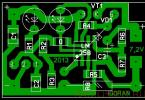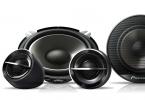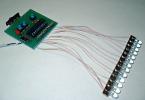Automotive developers are increasingly improving vehicles by equipping them with modern equipment. In particular, this applies to automatic transmissions. Like any other unit, a gearbox can have its advantages and disadvantages. We invite you to find out which ones it has - a video about its shortcomings is also available at the end of this material.
[Hide]
Basic information about the box
Motorists have many legends about DSG robotic boxes on Volkswagen cars. Sudden drops in traction and exorbitant repair costs are what everyone is afraid of.

Direct Shift Gearbox (DSG) stands for verbatim from German as: direct connection box. This is one of the many types of robotic boxes, as you know, a robot is a mechanical box, but with automated control.
When it is necessary to change gears, the computer gives a command that disconnects the driven clutch disk from the driving one, thereby separating the engine and the box, moves the gear shafts, then connects the disks back, renewing the process of transmitting torque. It must be said that the computer does not always cope with this operation quickly; it often needs even more time than the driver.

A double-clutch gearbox is a completely different matter; the schematic diagram of such a gearbox was invented by the French engineer Adolphe Kegresse. At the end of the thirties of the last century, he described the principle of operation of the double clutch.

The technologies of that time did not allow making a prototype, the design was forgotten until the early eighties, then they began to try the progressive box on the Ford Fiesta, Ford Ranger and Peugeot 205, and then on Audi and Porsche.
This type of gearbox is called a preselective gearbox (PKP); in addition to the DSG, there are several other types of preselective robots, for example, Porsche has pdk gearboxes developed jointly with the ZF company.
Renault Peugeot Citroen BMW Mercedes and Ferrari use Getrag gearboxes, and there are many different dual-clutch gearboxes for special purposes.

There are many selective gearboxes, but only Volkswagen DSG has a bad reputation. Largely due to the fact that they were the first to be used in the mass production of cars, but there are also subtleties, the DSG design comes in 3 types; in 2003, a 6-speed version of the DSG gearbox with the index dq250 was released.
It differs in that the double clutch discs worked in an oil bath, the friction force between the discs was relatively small, on the one hand, the clutch could transmit a large torque to the box with quite moderate wear, on the other hand, the mediator between the rubbing surfaces, the oil, provided large losses.
In 2008, Volkswagen took a risk and released the dq200 box, to avoid losses, the clutch went from wet to dry, like on conventional manual gearboxes. It was this option that gained unfortunate fame. The box worked very effectively, but there were problems with comfort and reliability, which we will discuss in detail below.

In 2008, S-tronik appeared for Audi with a longitudinal engine arrangement. You should only be wary of DSG 7; other variants of selective robots work without unnecessary complaints. Now the Volkswagen concern uses all three versions of DSG in parallel, as well as S-tronik.
A car equipped with a 7-speed DSG with a double dry clutch can cause problems in operation.
The problematic gearbox was installed on almost the entire Volkswagen model range of 2008 and to this day dsg7 continues to be installed on relatively weak modifications with engines up to 1.8 liters, with two-liter and larger engines, as well as diesel engines with a torque above 250 Hm, it is usually old and reliable dsg-6 with wet clutch.

The share of those who are not satisfied with the purchase is still quite large; owners are bothered by jerks when shifting gears up or down. This is the most common defect caused by the fact that the dry clutch discs close too abruptly, the effect is about the same as if you drop the clutch pedal on a car with a manual transmission.
The car also stops responding to pressing the gas pedal; the problem is a dry clutch. The mechatronic module that controls the clutch and gearbox is the main cause of DSG failures. True, there are other breakdowns, for example, premature wear of the shaft bearings or clutch release fork, as well as the adhesion of dirt on the contact sensor. It is rare, just like on any other gearbox.
Is it worth buying a car with a 7-speed DSG?
If you choose a used car, then definitely no, in the 1st year of production the peak of problems with the gearbox has come and the buyer of such a car automatically falls into the risk group; repair costs may not be comparable to high. As for new cars, it is possible to choose the 2013 version, the DSG gearbox has been modernized, and there are fewer problems.
What is DSG? In German, the abbreviation DSG stands for “direct gearbox” (Direkt Schalt Getriebe). It is often called “preselective,” that is, able to hold gears ready for the next shift.
The idea of creating such a checkpoint belongs to the French inventor Adolphe Kegresse. In the 30s of the last century, an automotive engineer collaborated with Citroen. He proposed installing a unit with two clutches and hydromechanical control on the front-wheel drive Citroen Traction Avant. The new transmission has not received widespread use due to its complex design.
Volkswagen Favorite Hoff technical consultant Maxim Ponomarenko spoke about the advantages and features of the box.
How DSG works
The fundamental difference between a preselective automatic transmission and others is in two clutches that quickly change gears. In a manual or robotic gearbox, to change gears, the clutch disc is disconnected from the flywheel, the driver or robotic computer selects the desired “speed”, and after that the disc snaps into place. During this time, torque is not transmitted to the box and the car loses dynamics.
The DSG system allows you to get rid of power failures. The box is based on the work of two shafts located coaxially: the first is hollow, and the second is inside it. The engine is connected to each of them through its own, separate multi-disc clutch - also external and internal. The gears of the even gears (2nd, 4th, 6th) are fixed on the primary, that is, the outer shaft, and the odd gears - 1st, 3rd, 5th and reverse gear - on the inner shaft.
When the car starts, the odd-numbered disk is pressed against the rotating flywheel, while the even-numbered “speed” disk is open. During acceleration, the computer unit of the box gives the command to prepare the second gear, so that at the moment it is turned on, it disconnects the odd-numbered row disk and immediately puts the even-numbered disk into operation. Tuned shift control ensures no loss of torque.
The DSG 6 robotic gearbox entered the Volkswagen assembly line in 2003. The double clutch on it operated in an oil bath, receiving the name “wet”. The oil in such a box takes away some of the power, increasing fuel consumption. In 2008, the German automaker introduced a seven-speed DSG 7 with a dry clutch.
DSG benefits
- The DSG box, due to the optimal modes of switching on the desired “speeds”, allows you to reduce fuel consumption. Cars with it consume about 10% less fuel than cars with a conventional gearbox.
- A distinctive feature of all such transmissions is dynamic acceleration. To shift up a gear, the box needs only 8 ms; it does not have the effect of rubber traction as on hydromechanical automatic transmissions.
- You can drive the DSG in manual mode, that is, change gears manually.
- This automatic transmission is 20% lighter than a similar hydromechanical transmission.
Disadvantages of DSG
- The cost of automatic transmission affects the price of the car, significantly increasing it.
- Expensive oil changes (on a six-speed gearbox) every 60 thousand kilometers. The total volume is 6.5 liters.
The preselective box is installed on different models and brands united under the name of the Volkswagen automaker: Audi TT (A1, A3, A4, S4, A5, A7, A6, Q5, R8), SEAT Ibiza (León, Altea), Škoda Octavia (Superb, Yeti), Volkswagen Polo (Golf, Jetta, Touran, New Beetle, Passat, Passat CC, Sharan, Scirocco, Caddy).
Extended warranty for DSG
Among many car owners, the dubious glory of a dual-clutch transmission has gained a foothold. The name DSG itself has become a symbol of an unreliable design with costly repairs. In fact, Volkswagen has long ago taken control of the current situation. An important step towards quality control is a large-scale service campaign.
The concern provides an extended warranty for seven-speed gearboxes manufactured before January 1, 2014. According to representatives of the automaker, the indicated period corresponds to the appearance on the assembly line of a modernized transmission without the typical problems of the previous generation. Special service conditions are limited to 150 thousand mileage or 5 years of age of the mechanism. The service promotion includes replacing synthetic oil with mineral oil, which is less aggressive towards electronic components. At the same time, the firmware of the automatic transmission control unit is updated. Detected faults are eliminated free of charge - this applies to repairs, replacement of individual elements or the entire transmission.
In any case, you should not be afraid of the DSG abbreviation: with the proper level of service, it will not let you down, and in terms of the number of advantages, the “smart robot” outperforms the classic automatic transmission. And the DSG gearbox will require less money for repairs compared to a conventional automatic transmission.
What malfunctions are typical for DSG?
The most common problem is the jolts that accompany the movement when changing gears. The clutch discs close too quickly and the car jerks. The second known drawback is vibration at start, clanging, grinding and other extraneous noises during speed changes.
The main reason for the incorrect operation of the seven-speed transmission is its “dry” clutch. It wears out quickly due to harsh operating conditions in dense city traffic, with congestion at low speeds. Therefore, the question “how to operate DSG?” There is one obvious answer - to avoid the “gas-brake” mode, because the main enemy of the robot is a traffic jam.
Other problems include wear on shaft bushings, clutch release forks, broken solenoid contacts, dirt on sensors and oil in antifreeze.
How to determine a DSG malfunction when buying a used car?
- Some gears do not engage - the box “skips” them.
- Gear shifting is accompanied by shocks - the box “kicks”.
- There is a hum when driving.
- The car vibrates when starting.
- An inspection on the lift shows that oil is leaking from the box.
If you suspect that the box is not working correctly, you should order an additional check, or postpone this option.
Trust your choice to trusted used car sites. FAVORIT MOTORS is a team of experienced specialists, whose results are confirmed by first places in sales ratings. We sell prepared cars that have undergone detailed diagnostics. They have no hidden defects and a “transparent” legal history. You are purchasing a car that exactly meets your expectations, exactly suited to your needs.
The DSG transmission combines a manual and automatic transmission. The bottom line is that the driver shifts gears manually, and the process itself is performed through electronics and automatic mechanisms. This gearbox was first put into mass production by Volkswagen AG.
DSG design
Automatic DSG works as follows. At the base of one axis there are two intermediate shafts, one of which is hollow and passes the second through itself. The gears and outer shaft are connected to two secondary shafts, on which pairs of gears for all odd and reverse gears are mounted. The transmission is engaged using a synchronizer and clutch. The entire process is controlled electronically via a hydraulic booster.
From a technical point of view The DSG box is a more advanced version of the manual transmission, it contains many of its components: primary and secondary shafts, clutch, synchronizers. Everything else is where the differences begin. The robotic transmission eliminates the need for the driver to manually depress the clutch pedal. This work is performed by electronics, which, taking into account the selected mode, independently connects the transmissions.
Features of the DSG gearbox

The DSG has five shafts, which, in combination with gears and two clutches, form a dual-circuit mechanism that transmits torque. Thereby cars on which this gearbox is installed pick up speed faster than cars with manual transmission. Shifting gears is no different from modern automatic transmissions, which is why DSG has long been used in sports cars where speed is of great importance. In addition, this transmission provides the ability to change gears manually - using the Tiptronic system or the steering wheel paddle.
Two multi-disc clutches provide torque transmission. When one of them is closed and one gear is working, the gears of the other are already in mesh; you just need to close the second clutch. When receiving a command from the control panel, the mechanism instantly disengages one clutch and closes the second, simultaneously activating the other gear.
Advantages of the DSG box
First of all, transmission makes acceleration time minimal and saves fuel, which is very relevant today. During operation, the shifts are imperceptible, resulting in the feeling that the car is driving in only one gear. There are only two pedals in the cabin - gas and brake. It's enough. The transmission selector is the same as for automatic transmissions. And if you don’t like something, you can always control the transmission manually by moving the lever down or up. The use of a robotic gearbox reduces fuel consumption. Car enthusiasts note that savings reach twenty percent compared to similar models equipped with an automatic transmission.
The video shows the assembly of the DSG gearbox:
A definite plus is the switching speed and acceleration dynamics. Cars on which such a gearbox is installed accelerate faster than their counterparts equipped with manual transmissions. At the same time, the power remains at the same level. DSG is a reliable unit and, if used correctly, will last a long time. But repairing this gearbox is impossible. Although it is quite possible that this problem will be solved in the near future.
Disadvantages of DSG
Among the disadvantages of the transmission are the following:
- , equipped with such a gearbox, increases significantly due to the technical complexity of the equipment.
- When accelerating and changing gears, slight jerking of the car is observed.
- Sharp acceleration causes slight delays - the transmission does not have time to jump through gear.
- Control units wear out quickly, resulting in the need for premature repairs.
All these shortcomings can be considered subjective. When the number of cars with such gearboxes increases, their cost decreases, and vehicles capable of servicing them will appear. As a result, the price will also decrease. It can be assumed that over time the DSG transmission will completely replace the manual gearbox.
The video shows the operating principle of the DSG gearbox:
What cars use DSG?
Today, robotic gearboxes are installed on cars of the following brands:
- Volkswagen (Golf, Sharan, Eos, Touran, Beetle “Beetle”, Bora, );
- (Superb, Octavia);
- Audi (A3, Q3, TT);
- Seat (Toledo, Alhambra).
Used on models with engine torque not exceeding 350 Nm.
The 7-speed gearbox is used on the following vehicles:
- Volkswagen (Golf, Passat, Sharan, Transporter, Caddy, Jetta, Touran, Beetle “Beetle”, Bora, Tiguan);
- Skoda (Fabia, Superb, Octavia);
- Seat (Ibiza, Leon, Altea);
- Audi (A3, Q3, TT).
Manufacturers install it only on cars equipped with a torque of up to 250 Nm.

As you know, today automakers offer consumers, taking into account the constantly growing demand for gearboxes of this type. Moreover, the automatic transmission can be represented not only by a “classic” hydromechanical automatic transmission, but also by a robot, a variator, and also with two clutches.
Also, the main modes and the actual performance in the cabin in relation to different types of automatic transmissions are often practically the same. This is done for ease of interaction. In other words, when buying a car, it can be difficult to determine which automatic transmission is installed in a particular case, since the automatic transmission lever (), panel and available modes may be the same.
Taking into account the fact that different types of machines have both pros and cons, as well as, in some cases it is important to understand exactly which box is on the machine. Next we will talk about how to determine whether it is an automatic or DSG, and what to look for.
Read in this article
DSG box or automatic: how to determine the type of gearbox
 Let's start with the fact that it has established itself as a reliable, durable and completely repairable unit. At the same time, many potential owners choose this type of gearbox even taking into account increased fuel consumption and a slight decrease in acceleration dynamics.
Let's start with the fact that it has established itself as a reliable, durable and completely repairable unit. At the same time, many potential owners choose this type of gearbox even taking into account increased fuel consumption and a slight decrease in acceleration dynamics.
As for preselective robots, combining the positive properties of a classic machine.
On the one hand, the production of such a box is cheaper, which reduces the final cost of the car. The driver also receives almost imperceptible gear changes, high transmission efficiency, fuel efficiency and excellent acceleration dynamics.
However, on the other hand, the resource of DSG (especially DSG-7) turned out to be noticeably lower (2-3 times) than that of torque converter automatic transmissions. Also considered a disadvantage is the high cost and complexity of repairing the DSG, the need to replace individual expensive elements, difficulty setting up, etc.
It is for this reason (usually in the secondary market) that cars with DSG sell worse than those with automatic transmission and even a CVT. Buyers themselves often either refuse to purchase or try to reduce the price as much as possible, citing the possible need for serious repairs of such a box already at 100-150 thousand km.
Naturally, the car seller is not interested in a significant reduction in cost. If we remember that it is difficult to visually distinguish a DSG from an automatic, inexperienced buyers are often deceived by claiming that the car has a regular automatic transmission, DSG, etc. Adding to the complexity is the fact that some models can be equipped with both DSG and a conventional automatic transmission.
Still in pursuit of profit or in order to quickly sell a car, in some cases sellers go even further, changing the automatic transmission selector with the DSG inscription to a simple handle, removing the DSG “nameplate” from the lever, completely covering the handle with leather, etc.
As a result, especially if the lever is from a classic automatic, new owners often do not know what kind of transmission is actually installed on their car. So, in order to clearly understand which gearbox the car comes with, you need to be able to distinguish DSG from automatic transmission.
First of all, among the main distinctive features of the DSG are:
As you can see, with so many different types of automatic transmissions, it is important to consider their features and differences. In practice, you need to be able to distinguish.
The fact is that although all of these types of transmissions are automatic, they differ from each other both in terms of design, reliability and quality of work. For example, the CVT gearbox is the most comfortable, but is not suitable for aggressive driving.
An automatic transmission can consume more fuel, but is more reliable. the cheapest, but the gearbox is thoughtful, there may be jerks and dips at the moment of gear shifting. As for the DSG, although such a gearbox works no worse than a classic automatic, the main disadvantage is the high price and low service life.
Finally, we note that, taking into account the above information, it is necessary to accurately determine which box is on the car, which may, as a result, become a reason for refusing to purchase or for reasonable bargaining with the seller.
Read also
Differences between a robotic gearbox and an automatic transmission: what to pay attention to. How to distinguish a robot from an automatic machine (visually, in motion). Recommendations.






